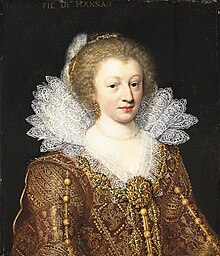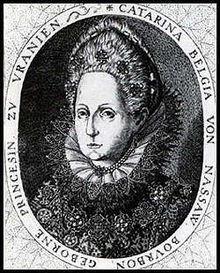Katharina Belgica of Orange-Nassau
Katharina Belgica (born July 31, 1578 in Antwerp , † April 12, 1648 in The Hague ) was a daughter of Prince William I of Orange-Nassau , the silent one , (1533–1584) and his third wife Charlotte of Bourbon-Montpensier (1546-1582).
The Latinized form of the name Belgi c a was used in official documents of the firm. She wrote herself Catarina Belgia .
Marriage and offspring
Little is known about her childhood. On October 23 / November 3, 1596, she married Count Philipp Ludwig II of Hanau-Münzenberg in Dillenburg . Common children were:
- Charlotte Louise (born August 10, 1597, Windecken ; † July 15, 1649 in Kassel ), not married
- Daughter (born July 29, 1598 - † August 9, 1598), may have died unbaptized
- Philipp Ulrich (born January 2, 1601; † April 7, 1604, Steinau )
- Amalia Elisabeth (also: Amalie and Amélie) (born January 29, 1602, Hanau; † August 8, 1651), Kassel, married to Landgrave Wilhelm V of Hessen-Kassel
- Katharina Juliane (* March 17, 1604; † December 28, 1668, Hanau), buried in the count's crypt in Laubach , married to September 11, 1631 Count Albert Otto II of Solms-Laubach, Rödelheim and Assenheim , 2 .) March 31, 1642 Moritz Christian von Wied-Runkel .
- Philipp Moritz (born August 25, 1605 - † August 3, 1638), buried in the Marienkirche in Hanau, successor
- Wilhelm Reinhard (born September 20, 1607; † September 5, 1630, Aachen), buried in the Marienkirche in Hanau
- Heinrich Ludwig (7 May 1609 - 21 July 1632 during the siege of Maastricht )
- Friedrich Ludwig (* July 27, 1610 - † October 4, 1628, Paris), buried in the hereditary funeral of the dukes of Bouillon in Sedan
- Jakob Johann (* July 28, 1612; † June 9/19, 1636, died near Zabern ), buried in St. Nikolai in Strasbourg
Regency
After the death of her husband in 1612, she was the sole guardian of the underage heir, Philipp Moritz , until he came of age in 1627. It was the first case in the long series of Count Hanau Guardianships in which the ward's mother was alone from the Imperial Court of Justice and was confirmed as guardian without the assistance of other relatives.
Violent arguments broke out with her son Philipp Moritz after his 18th birthday when, according to his father's will, he reached the age of majority, but his mother was also supposed to rule until his 25th birthday. Points of contention were the amount of her widow's pension, the final account of the guardianship, the costs and the continuation of the legal dispute with Count Albrecht from the secondary school Hanau-Münzenberg-Schwarzenfels and the claim of Katharina Belgia derived from the will of Philip Ludwig II, despite the age of majority of Wanting to continue to govern. A settlement concluded in 1628 could not rectify this either. She tried to ignore an opinion from the law faculty of the University of Marburg , which was to the disadvantage of Katharina Belgia. The two even litigated against each other before the Reich Chamber of Commerce. The mutual manners were rude: Philipp Moritz threw his mother out of the Hanau City Palace in the meantime , but compensated her for it in 1629.
The castle in Windecken was intended as her widow's residence . This, however, was not renovated and was occupied by imperial troops as quarters. Philipp Ludwig II also had a small castle built for her, which stood roughly on the site of today 's Philippsruhe Castle in Hanau-Kesselstadt .
Age
It remained in the county of Hanau-Münzenberg until 1634, when the effects of the Thirty Years' War hit the county in full. With most of the count's family, she fled to the Netherlands to her half-brother Prince Friedrich Heinrich von Oranien-Nassau (1584–1647), who ruled there as governor . There she died on April 12, 1648 and was buried on May 5, 1648 in the Nieuwe Kerk in Delft .
rating
She continued her deceased husband's policy of modernization and economic development for the County of Hanau-Munzenberg , and also supported the further development of the Higher State School . It is difficult to determine your own historical performance. It was certainly there, but is largely lost in literature behind the appreciation of its husband.
Individual evidence
- ↑ On this and on the other different spellings of the name: Eckhard Meise : Useless discussions on Hanau's history . In: New Magazine for Hanau History 2017, pp. 184–207 (187ff).
- ↑ Cuno, p. 126
- ^ In the Marburg State Archives , inventory 81. Hanau Government, A 33.17, there is a wooden folder with the design of an epitaph for Philipp Ulrich in the church in Steinau . Further archival documents on his person: ibid. 86. Disordered inventory, no. 31608; ibid., funeral sermon: 81st Hanau government, A 32.7, evidence: catalog of funeral sermons and other memorial documents in the Marburg State Archives. Sigmaringen 1992 = Marburg personal font research 14
literature
- Barbara Bott: A picture of Countess Katharina Belgia as a child . In: Hanauer Geschichtsblätter 20 (1965). Pp. 279-292.
- Reinhard Dietrich : The state constitution in the Hanauischen = Hanauer Geschichtsblätter 34. Hanau 1996. ISBN 3-9801933-6-5 .
- Pauline Puppel: Amelie Elisabeth - A woman from Hanau as Landgravine of Hessen-Kassel , in: The Thirty Years War in Hanau and the surrounding area, ed. from the Hanauer Geschichtsverein 1877 eV on the occasion of the 375th return of the relief of the city, Hanau 2011, p. 151–196.
- Pauline Puppel: The problem of exercising guardianship in ruling houses by mothers, discussed and analyzed using the example of Countess Catarina Belgia von Hanau-Münzenberg . Marburg 1997 [Staatsexamensarbeit], unprinted.
- Pauline Puppel: On the change of power in Hanau-Münzenberg in 1625 . In: New Magazine for Hanau History 2014, pp. 72–85.
| personal data | |
|---|---|
| SURNAME | Katharina Belgica of Orange-Nassau |
| BRIEF DESCRIPTION | Princess of Orange-Nassau, by marriage Countess Hanau-Munzenberg |
| DATE OF BIRTH | July 31, 1578 |
| PLACE OF BIRTH | Antwerp |
| DATE OF DEATH | April 12, 1648 |
| Place of death | The hague |


